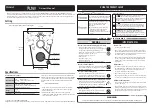
65 Aleksandar Stamboliyski Str., 8000 Bourgas, Bulgaria
Tel: +359 56 820027, Fax: +359 56 836700
E-mail: [email protected] ,Web: www.devabroadcast.com
- 81 -
APPENDIX B.1
RDS APPLICATIONS SUPPORTED
Following is an alphabetical list of the RDS applications supported by Radio Explorer II. The
standardized RDS application abbreviation is followed by an expansion of the application name
and a short explanation of the function.
NOTE:
Depending of the currently selected User interface the following RDS Applications are
supported:
•
Via WEB Interface: AF, CT, DI, M/S, PI, PIN, PS, PTY, RT, RT+, TA, TMC and TP
•
Via Logger: PI, PTY, TA, TP, M/S, DI, PS, AF, RT
•
Via DEVA Device Manager Software: All RDS Applications
AF
List of Alternative Frequencies: In order holes in the coverage area to be filled, list of all
frequencies where identical program could be heard simultaneously can be included by the network
broadcaster or one with low-power rebroadcast transmitters (translators). The RDS receiver
(particularlythe upscale car radio) constantly searches for the best signal that carries the same
program. The radio will re-tune without noticeable interruption, when a better signal is found.
The principal utility of this RDS function is with European radio networks and US stations with
‘translators.’
CT
Clock Time and date: Time and date codes should use Coordinated Universal Time (UTC) and
Modified Julian Day (MJD). If MJD = 0, the receiver should not be updated. The listener, however,
will not use this information directly and the conversion to local time and date will be made in
the receiver’s circuitry. CT is used as time stamp by various RDS applications and thus it must be
accurate.
DI
Decoder Information: This is one of several ‘flags’ that convey yes/no or other very basic data.
This flag helps the receiver to indicate whether the broadcast is monaural or is transmitted in any
of several methods of stereo or binaural broadcasting. As many as 16 encoding options may be
accommodated! This is a rather esoteric function and, thus far, remains unused both in Europe and
in the US.
ECC
Extended Country Code: RDS uses its own country codes. The first most significant bits of the
PI code carry the RDS country code. The four bit coding structure only permits the definition of 15
different codes, 1 to F (hex). Since there are much more countries to be identified, some countries
have to share the same code which does not permit unique identification. Hence there is the need
to use the Extended Country Code which is transmitted in Variant 0 of Block 3 in type 1A groups
and together with the country identification in bits b15 to b12 of the PI code render a unique
combination. The ECC consists of eight bits.






































